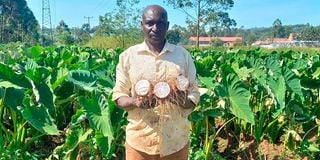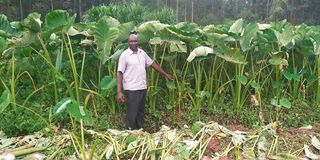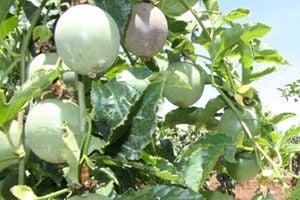
James Nyagwoka displays plays harvested arrowroots at his farm in Nyaribari Chache, Kisii County.
Many residents of Kisii and Nyamira counties often put the parts of their land near rivers under eucalyptus trees.
After fortunes from tea started to fall, farmers in the two counties resorted to planting eucalyptus trees.
For 64-year-old James Nyagwoka, however, growing eucalyptus trees never crossed his mind.
He, instead, ventured into arrowroot farming on his farm in his Kegati village, Nyaribari Chache constituency, Kisii County.

James Nyagwoka at his arrowroots farm in Nyaribari Chache, Kisii County.
Arrowroots have made Nyagwoka the man he is. Nyagwoka has been growing arrowroots for two decades and is not about to stop.
Seeds of Gold visited Nyagwoka at his farm where he shared insights into the arrowroot venture.
Nyagwoka says the enterprise has enabled him educate his five children up to university and build a permanent house.
“I started with just 200 suckers I had uprooted from the banks of the river near this farm,” he says, adding that he inherited the land from his father.
“From those 200 suckers, I propagated more stems until the current number of at least 100,000.”
Most residents of South Nyanza have the notion that arrowroots or nduma only do well in soggy soils. Nyagwoka says experience has shown him that this is not the case.
He, however, adds that for good nduma yields, the soil must be fertile, fine and well-watered.
Nyagwoka explains that before one ventures into any enterprise, it is good to do pre-visits to other farms that have excelled. This enables them to learn a thing or two so that implementation can be perfected.
According to Nyagwoka, the field needs to be prepared before the arrowroot suckers are planted. Digging should be deep and even.
“I ensure there are no weeds, then dig trenches 30 centimetres deep,” Nyagwoka says.
The distance from one trench to the other should be about half a metre. This ensures proper use of the land, the veteran arrowroot farmer adds.
Once the trenches have been made, a farmer needs to add organic manure.
“After applying the manure, I plant the suckers in the trenches. They should not be too close to one another,” he says.
Nyagwoka says his arrowroots take seven to eight months to mature.
As they grow, he pays close attention to the plants, ensuring the soil is not heaped around the stems.
When weeding, Nyagwoka ensures the soil is not close to the stalks. This in return aids the formation of bigger arrowroots.
“Customers will come or go, depending on the size of the nduma. The bigger the arrowroots, the more attractive they are and the more money one makes,” he says.
Nyagwoka has not had the challenge of arrowroot diseases and is never comfortable with using herbicides and pesticides. Many clients insist on organically-grown food.
“Pesticides can damage the roots of the plants and make them wilt. If the plant had started producing arrowroots, it can end up rotting,” he adds, saying he has witnessed that on several other farms.
His biggest challenge is porcupine attack. These nocturnal animals destroy arrowroots soon after rooting begins.
Porcupines pose a serious threat to any arrowroot farm as they can uproot an entire crop. With the help of family members and friends, Nyagwoka literally drives the beasts from the farm.
The type of arrowroot Nyagwoka grows has broad dark green leaves. There is another type with purple leaves, which he grows on a smaller scale.
From a single row measuring 50 metres, Nyagwoka can harvest arrowroots that can be sold for Sh15,000. He makes a tidy sum from his six-acre farm, with harvests being staggered.
Most of his customers come from Kisii and neighbouring towns. Nyagwoka says a small sack of arrowroots goes for Sh3,000.
“I also have customers in Nairobi and Nakuru,” he says.
To ensure a steady supply to his customers, Nyagwoka has divided his farm into portions with the arrowroots planted at different times of the year.
This ensures harvesting is throughout the year. Staggering the harvests also means a relatively steady income.
Farmers in Kegati and neighbouring villages have begun growing arrowroots after witnessing Nyagwoka’s success story. He gives them free advice and training.
Nyagwoka never fails to attend agricultural fairs in Kisii and neighbouring regions to get insights on arrowroot growing.
Arrowroots are rich in starch and a good source of energy. They are often eaten for breakfast and make a good snack.









